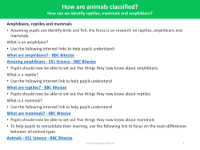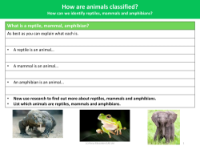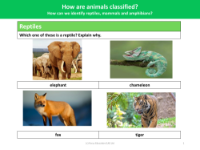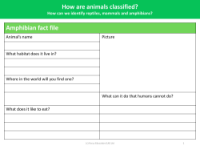How can we identify reptiles, mammals and amphibians? - Presentation

Science Resource Description
Understanding how to classify animals into groups such as reptiles, mammals, and amphibians is a fundamental aspect of biology. Reptiles are cold-blooded animals that usually lay eggs and have scaly skin. They do not maintain a constant internal body temperature, which means they rely on external sources of heat to regulate their temperature. Examples of reptiles include snakes, lizards, and turtles. By contrast, mammals are warm-blooded creatures known for their ability to regulate their own body temperature, have hair or fur on their bodies, and most give birth to live young. Mammals also produce milk to feed their offspring, with familiar examples being humans, elephants, and tigers.
Amphibians are unique in that they spend part of their lives in water and part on land. They typically have moist skin, which helps in their respiration process, and they go through a life cycle that includes metamorphosis, transitioning from water-breathing larvae to air-breathing adults. Frogs, toads, and salamanders are all examples of amphibians. To assist pupils in learning about these animal groups, a series of interactive resources and fact-finding activities are used. These activities include researching specific animals, identifying their habitats, dietary preferences, and unique abilities, as well as understanding their distinct physical characteristics that set them apart from other animal classes.






